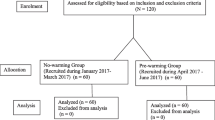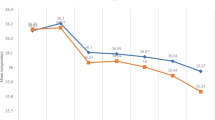Abstract
Objectives
The incidence of postoperative shivering is known to be inversely associated with core body temperature. However, previous studies have pointed out that the threshold of shivering could be affected by peripheral temperature or anesthetic agents. These reports pointed specific drugs, though, anesthesia techniques have since advanced considerably. This study aimed to investigate factors associated with postoperative shivering in the context of the current body warming practice.
Methods
The institutional clinical research ethics committee of Kyushu University approved the study protocol (IRB Clinical Research number 2019-233). This retrospective study involved 340 patients who had undergone radical surgery for gynecological cancer treatment under general anesthesia at our center from December 2012 to June 2019. Logistic regression analysis was performed to estimate the odds ratio (OR) for the incidence of postoperative shivering.
Results
Postoperative shivering developed in 109 out of 340 patients. After multivariate-adjusted logistic regression, the incidences of postoperative shivering decreased significantly with increasing patient age (OR = 0.96; 95%CI: 0.93–0.98; p = 0.0004). Volatile anesthesia technique was less inclined to shiver after surgery than TIVA (OR = 0.55; 95%CI: 0.30–0.99; p = 0.04). Acetaminophen was much less used in the shivering group than in the non-shivering group (OR = 0.49; 95%CI: 0.25–0.94; p = 0.03).
Conclusions
This study indicated that the development of shivering in patients receiving the anesthetic technique currently used in our hospital was associated with use of acetaminophen or volatile agents, and patient age.

Similar content being viewed by others
References
Ciofolo MJ, Clergue F, Devilliers C, Ben Ammar M, Viars P. Changes in ventilation, oxygen uptake, and carbon dioxide output during recovery from isoflurane anesthesia. Anesthesiology. 1989;70(5):737–41.
Nakagawa T, Hashimoto M, Hashimoto Y, Shirozu K, Hoka S. The effects of tramadol on postoperative shivering after sevoflurane and remifentanil anesthesia. BMC Anesthesiol. 2017;17(1):1.
Li X, Zhou M, Xia Q, Li W, Zhang Y. Effect of parecoxib sodium on postoperative shivering: a randomised, double-blind clinical trial. Eur J Anaesthesiol. 2014;31(4):225–30.
Mahoori A, Noroozinia H, Hasani E, Soltanahmadi M. Comparison of ondansetron and meperidine for treatment of postoperative shivering: a randomized controlled clinical trial. Iran Red Crescent Med J. 2014;16(8):e13079.
Ram Kiran KS, Sangineni K. The effect of forced-air warmer, ondansetron or their combination on shivering in pregnant women coming for elective cesarean section under spinal anesthesia: a prospective, randomized controlled comparative study. Anesth Essays Res. 2019;13(1):19–24.
Safavi M, Honarmand A, Khosravi F, Sariazdi H, Nazem M. The evaluation of effects two different doses of hydrocortisone on the intensity of perioperative shivering in elective surgery under spinal anesthesia: A double-blind randomized controlled trial study. J Res Med Sci. 2016;21:40.
Ng KT, Yap JLL, Izham IN, Teoh WY, Kwok PE, Koh WJ. The effect of intravenous magnesium on postoperative morphine consumption in noncardiac surgery: a systematic review and meta-analysis with trial sequential analysis. Eur J Anaesthesiol. 2020;37:212–23.
Annadata R, Sessler DI, Tayefeh F, Kurz A, Dechert M. Desflurane slightly increases the sweating threshold but produces marked, nonlinear decreases in the vasoconstriction and shivering thresholds. Anesthesiology. 1995;83(6):1205–11.
Kurz A, Go JC, Sessler DI, Kaer K, Larson MD, Bjorksten AR. Alfentanil slightly increases the sweating threshold and markedly reduces the vasoconstriction and shivering thresholds. Anesthesiology. 1995;83(2):293–9.
Matsukawa T, Kurz A, Sessler DI, Bjorksten AR, Merrifield B, Cheng C. Propofol linearly reduces the vasoconstriction and shivering thresholds. Anesthesiology. 1995;82(5):1169–80.
Hanagata K, Matsukawa T, Sessler DI, Miyaji T, Funayama T, Koshimizu M, Kashimoto S, Kumazawa T. Isoflurane and sevoflurane produce a dose-dependent reduction in the shivering threshold in rabbits. Anesth Analg. 1995;81(3):581–4.
Bicer C, Esmaoglu A, Akin A, Boyaci A. Dexmedetomidine and meperidine prevent postanaesthetic shivering. Eur J Anaesthesiol. 2006;23(2):149–53.
Zhou Y, Mannan A, Han Y, Liu H, Guan HL, Gao X, Dai MS, Cao JL. Efficacy and safety of prophylactic use of ketamine for prevention of postanesthetic shivering: a systematic review and meta-analysis. BMC Anesthesiol. 2019;19(1):245.
Aouad MT, Zeeni C, Al Nawwar R, Siddik-Sayyid SM, Barakat HB, Elias S, Yazbeck Karam VG. Dexmedetomidine for improved quality of emergence from general anesthesia: a dose-finding study. Anesth Analg. 2019;129(6):1504–11.
Kurz A, Ikeda T, Sessler DI, Larson MD, Bjorksten AR, Dechert M, Christensen R. Meperidine decreases the shivering threshold twice as much as the vasoconstriction threshold. Anesthesiology. 1997;86(5):1046–54.
Jayaraj A, Balachander H, Kuppusamy SK, Arusamy S, Rai Y, Siddiqui N. Comparison of meperidine, tramadol and fentanyl for post-spinal shivering prevention during cesarean delivery: a double-blind randomized controlled trial. J Obstet Gynaecol Res. 2019;45(11):2202–8.
Lamontagne C, Lesage S, Villeneuve E, Lidzborski E, Derstenfeld A, Crochetiere C. Intravenous dexmedetomidine for the treatment of shivering during Cesarean delivery under neuraxial anesthesia: a randomized-controlled trial. Can J Anaesth. 2019;66(7):762–71.
Cobb B, Cho Y, Hilton G, Ting V, Carvalho B. Active warming utilizing combined IV fluid and forced-air warming decreases hypothermia and improves maternal comfort during cesarean delivery: a randomized control trial. Anesth Analg. 2016;122(5):1490–7.
Jun JH, Chung MH, Jun IJ, Kim Y, Kim H, Kim JH, Choi YR, Choi EM. Efficacy of forced-air warming and warmed intravenous fluid for prevention of hypothermia and shivering during caesarean delivery under spinal anaesthesia: a randomised controlled trial. Eur J Anaesthesiol. 2019;36(6):442–8.
Akata T, Setoguchi H, Shirozu K, Yoshino J. Reliability of temperatures measured at standard monitoring sites as an index of brain temperature during deep hypothermic cardiopulmonary bypass conducted for thoracic aortic reconstruction. J Thorac Cardiovasc Surg. 2007;133(6):1559–655.
Khan F, Spence VA, Belch JJ. Cutaneous vascular responses and thermoregulation in relation to age. Clin Sci. 1992;82(5):521–8.
De Witte J, Sessler DI. Perioperative shivering: physiology and pharmacology. Anesthesiology. 2002;96(2):467–84.
Zhang R, Chen X, Xiao Y. The effects of a forced-air warming system plus electric blanket for elderly patients undergoing transurethral resection of the prostate: a randomized controlled trial. Medicine (Baltimore). 2018;97(45):e13119.
Frank SM, Beattie C, Christopherson R, Norris EJ, Rock P, Parker S, Kimball AW Jr. Epidural versus general anesthesia, ambient operating room temperature, and patient age as predictors of inadvertent hypothermia. Anesthesiology. 1992;77(2):252–7.
Rohm KD, Riechmann J, Boldt J, Suttner SW, Piper SN. Total intravenous anesthesia with propofol and remifentanil is associated with a nearly twofold higher incidence in postanesthetic shivering than desflurane-fentanyl anesthesia. Med Sci Monit. 2006;12(11):452–6.
Schraag S, Pradelli L, Alsaleh AJO, Bellone M, Ghetti G, Chung TL, Westphal M, Rehberg S. Propofol vs. inhalational agents to maintain general anaesthesia in ambulatory and in-patient surgery: a systematic review and meta-analysis. BMC Anesthesiol. 2018;18(1):162.
Kinjo T, Tadokoro T, Tokushige A, Zamami T, Taira S, Ikehara Y, Tsuhako C, Ohtsu H, Ueda S, Kakinohana M. Effects of perioperative administration of acetaminophen on postoperative shivering: a randomized, triple-blind, placebo-controlled trial. Anesth Analg. 2019. https://doi.org/10.1213/ANE.0000000000004306.
Aoki Y, Aoshima Y, Atsumi K, Kaminaka R, Nakau R, Yanagida K, Kora M, Fujii S, Yokoyama J. Perioperative amino acid infusion for preventing hypothermia and improving clinical outcomes during surgery under general anesthesia: a systematic review and meta-analysis. Anesth Analg. 2017;125(3):793–802.
Cheng C, Matsukawa T, Sessler DI, Ozaki M, Kurz A, Merrifield B, Lin H, Olofsson P. Increasing mean skin temperature linearly reduces the core-temperature thresholds for vasoconstriction and shivering in humans. Anesthesiology. 1995;82(5):1160–8.
Madden CJ, Morrison SF. Central nervous system circuits that control body temperature. Neurosci Lett. 2019;696:225–32.
Rubinstein EH, Sessler DI. Skin-surface temperature gradients correlate with fingertip blood flow in humans. Anesthesiology. 1990;73(3):541–5.
Sessler DI, Olofsson CI, Rubinstein EH. The thermoregulatory threshold in humans during nitrous oxide-fentanyl anesthesia. Anesthesiology. 1988;69(3):357–64.
Funding
None.
Author information
Authors and Affiliations
Contributions
New author “KU” performed multiple analysis and propensity score matching analysis in this revised version. This propensity analysis was absolutely needed due to reviewer’s comments and all original authors could not perform it.
Corresponding author
Ethics declarations
Conflict of interest
The authors declare that they have no conflict of interest.
IRB
Faculty of Medical sciences, Kyushu University Institutional Review Board Clinical Research number #2019-233
Additional information
Publisher's Note
Springer Nature remains neutral with regard to jurisdictional claims in published maps and institutional affiliations.
About this article
Cite this article
Shirozu, K., Umehara, K., Ikeda, M. et al. Incidence of postoperative shivering decreased with the use of acetaminophen: a propensity score matching analysis. J Anesth 34, 383–389 (2020). https://doi.org/10.1007/s00540-020-02763-1
Received:
Accepted:
Published:
Issue Date:
DOI: https://doi.org/10.1007/s00540-020-02763-1




